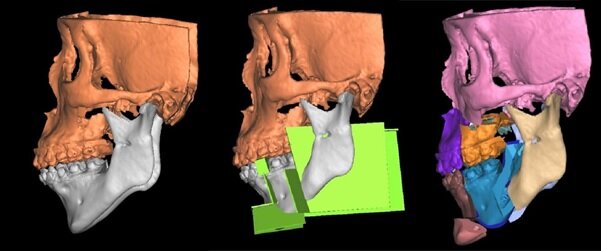3D surgical planning of the SMA as part of jaw advancement surgery for patients with severe obstructive sleep apnea. Credit: University of Hong Kong
Obstructive sleep apnea (OSA) is a condition in which the airway becomes blocked during sleep. It can cause multiple episodes of shallow breathing (hypopnea) or temporary cessation of breathing (apnea) during sleep. If left untreated, patients with OSA may experience reduced quality of life and health problems in more severe cases.
Patients with moderate to severe OSA, e.g. AHI (apnea-hypopnea index) of 15 events or more per hour may require surgery to widen their airway if non-surgical treatment, such as using a continuous positive airway pressure ventilator, fails. Surgical treatment of OSA involves removing or repositioning soft tissues (eg, tonsils) or advancing the jaw to expand the upper airway, as patients with OSA often have smaller or sunken jaws.
Jaw advancement surgery is an effective treatment for OSA. However, it can change facial appearance and “bite”, especially among East Asians who typically have more prominent lips than Caucasians. This makes it more difficult to perform jaw advancement surgery without compromising their facial aesthetics.
The Oral and Maxillofacial Surgery (OMFS) research group at The University of Hong Kong (HKU) School of Dentistry recently conducted a pilot study to measure whether a new jaw surgery technique could help improve moderate to severe OSA.
The findings, now published in International Journal of Oral and Maxillofacial Surgeryindicate that this surgery can significantly relieve sleep apnea and also maintain or even improve the patient’s appearance.
All patients in the study with moderate to severe OSA experienced a 50% or greater reduction in breathing disturbances at night after surgery, and 58% of patients were considered cured, with no signs of sleep apnea.
The jaw surgery technique involves a multi-part osteotomy (cutting and reshaping of the bone) of the mandible called segmental mandibular advancement (SMA). It is a combination of a procedure to lift part of the front jaw to create space and a procedure to advance the entire lower jaw.
The operation is performed to bring about significant widening of the skeletal airway at the base of the tongue, as well as an attractive facial esthetics and functional bite outcome.
The team’s lead researcher, Dr. Mike YY Leung, Clinical Associate Professor of oral and maxillofacial surgery, expressed that this multi-part jaw correction surgery, as adopted at SMA, has been used to correct facial deformities in Hong Kong for many years, but Their study leads several steps in front.
“It was the first study to demonstrate that SMA could also effectively bring improvement to OSA. The uniqueness of facial features in the East Asian population was the reason for using this method, which takes into account aesthetics and function of the jaws over the significant expansion of the airways,” he said.
Twelve patients in Hong Kong with moderate to severe OSA, referred by different dentists, general practitioners and ENT specialists were evaluated for this study. They received SMA as a major part of their jaw growth surgery.
AHI, the diagnostic tool used to measure the presence and severity of OSA, can be classified into three categories. Mild AHI usually involves five to 15 apnea or hypopnea events per hour. Moderate AHI sees 16 to 30 events per hour, while severe AHI records more than 30 events per hour.
The study found that surgery helped improve preoperative AHI from 42.4 events per hour to nine events per hour on average at one year postoperatively.
Surgical success, as defined by a reduction in baseline AHI of 50% or more, was seen in 11 of 12 patients. This means that almost all patients experienced a 50% or more reduction in breathing disturbances at night.
Surgical cure, as defined by an AHI of fewer than five events per hour, was also observed in seven of the 12 patients. Thus, 58% of patients were cured after surgery, without showing signs of sleep apnea.
On average, airway volume was also found to increase by 2.8 times after surgery, allowing patients to breathe better. These figures remained stable over the one-year study period.
There was no incidence of major surgical complications, thus showing that SMA is potentially a safe and effective procedure for patients with severe OSA.
Dr. Joan CC Wan, co-investigator of the project, said the study’s findings are encouraging, showing significant improvement even in severe cases of OSA as well as consistent results.
“We believe that the pilot study has set the cornerstone for a larger study that can observe the long-term results of this technique and help us compare it with other treatment methods for OSA,” said Dr.
More information:
YY Leung et al, Segmental mandibular advancement for moderate to severe obstructive sleep apnea: a pilot study, International Journal of Oral and Maxillofacial Surgery (2022). DOI: 10.1016/j.ijom.2022.11.009
Reference: Novel jaw surgery concept effective in treating moderate to severe obstructive sleep apnea (2023, January 10) Retrieved January 25, 2024 from
This document is subject to copyright. Except for any fair dealing for purposes of private study or research, no part may be reproduced without written permission. Content is provided for informational purposes only.


